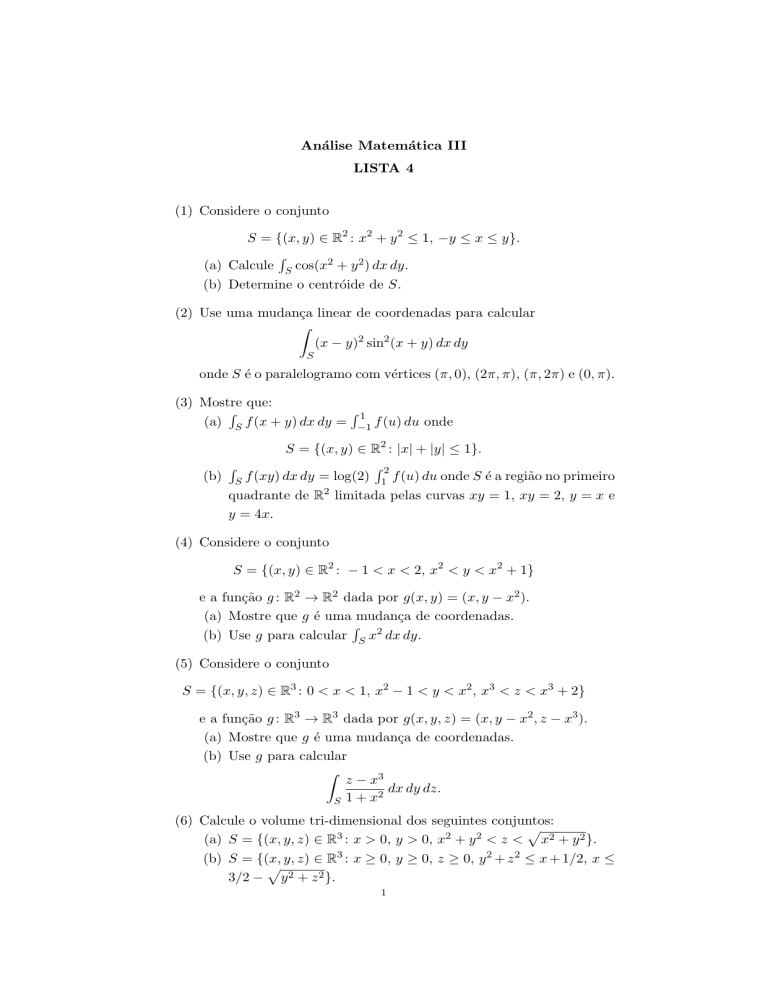
Análise Matemática III
LISTA 4
(1) Considere o conjunto
S = {(x, y) ∈ R2 : x2 + y 2 ≤ 1, −y ≤ x ≤ y}.
R
(a) Calcule S cos(x2 + y 2 ) dx dy.
(b) Determine o centróide de S.
(2) Use uma mudança linear de coordenadas para calcular
Z
(x − y)2 sin2 (x + y) dx dy
S
onde S é o paralelogramo com vértices (π, 0), (2π, π), (π, 2π) e (0, π).
(3) Mostre que:
R
R1
(a) S f (x + y) dx dy = −1 f (u) du onde
S = {(x, y) ∈ R2 : |x| + |y| ≤ 1}.
R2
R
(b) S f (xy) dx dy = log(2) 1 f (u) du onde S é a região no primeiro
quadrante de R2 limitada pelas curvas xy = 1, xy = 2, y = x e
y = 4x.
(4) Considere o conjunto
S = {(x, y) ∈ R2 : − 1 < x < 2, x2 < y < x2 + 1}
e a função g : R2 → R2 dada por g(x, y) = (x, y − x2 ).
(a) Mostre que g é uma mudança de coordenadas.
R
(b) Use g para calcular S x2 dx dy.
(5) Considere o conjunto
S = {(x, y, z) ∈ R3 : 0 < x < 1, x2 − 1 < y < x2 , x3 < z < x3 + 2}
e a função g : R3 → R3 dada por g(x, y, z) = (x, y − x2 , z − x3 ).
(a) Mostre que g é uma mudança de coordenadas.
(b) Use g para calcular
Z
z − x3
dx dy dz.
2
S 1+x
(6) Calcule o volume tri-dimensional dos seguintes conjuntos:
p
(a) S = {(x, y, z) ∈ R3 : x > 0, y > 0, x2 + y 2 < z < x2 + y 2 }.
(b) S = {(x, y, z) ∈ R3 : x ≥ 0, y ≥ 0, z ≥ 0, y 2 + z 2 ≤ x + 1/2, x ≤
p
3/2 − y 2 + z 2 }.
1
2
(c) S = {(x, y, z) ∈ R3 : x > 0, y > 0, 0 < z <
z 2 < 1}.
p
x2 + y 2 , x 2 + y 2 +
(7) * Para cada a > 0 e n ∈ N, considere o conjunto
(
)
n
X
n
Bn (a) = x ∈ R :
|xi | ≤ a .
i=1
Prove que o volume n-dimensional de Bn (a) é dado por
(2a)n
.
n!
Sugestão: Mostre que voln Bn (a) = an voln Bn (1) e que voln+1 Bn+1 (1) =
2/(n + 1) voln Bn (1) para qualquer n ∈ N.
voln Bn (a) =
